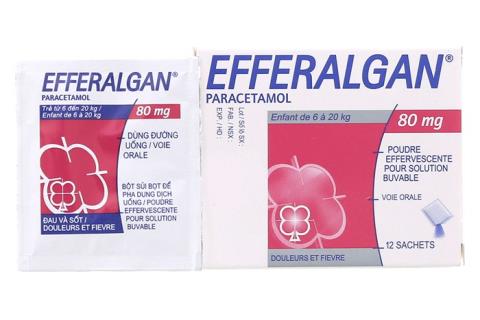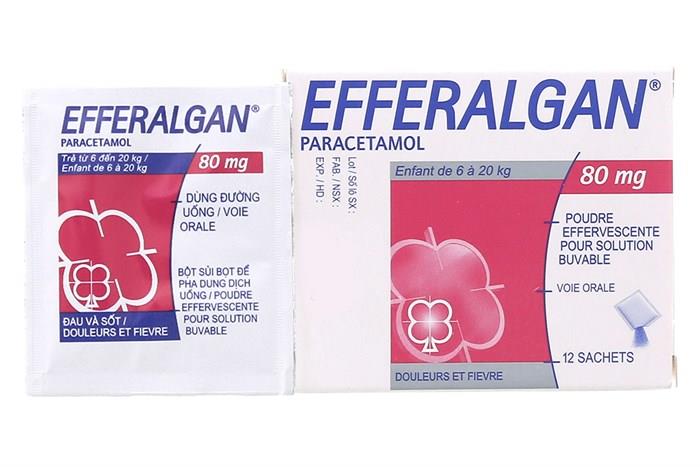Efferalgan effervescent powder for children: what you need to know

What is Efferalgan? What is Efferalgan used for? What should be noted about possible side effects while taking the drug? Let's take a closer look at SignsSymptomsList about Efferalgan in the article analyzed below!
content
- 1. What is Efferalgan?
- 2. Uses and users of the drug Efferalgan
- 3. Efferalgan should not be used if
- 4. How to use Efferalgan effectively
- 5. Side effects
- 6. Interaction occurs when taking Efferalgan
- 7. Notes when using Efferalgan
- 8. Treatment of drug overdose Efferalgan
- 9. What to do when you miss a dose of Efferalgan
- 10. How to preserve
1. What is Efferalgan?

Each tablet contains:
Active
- Paracetamol………………………………………………………………………………………………..80mg
Excipients
- Anhydrous citric acid
- Anhydrous sodium carbonate, Sodium hydrogen carbonate
- Sorbitol, Sodium Saccharin
- Sodium docusate, Sodium benzoate
- Povidone.
2. Uses and users of the drug Efferalgan
- The target audience of this Efferalgan drug is children
- Efferalgan is indicated for the treatment of symptoms
+ Pain or fever such as headache
+ Treatment of conditions such as flu, toothache, muscle aches
+ In addition, the drug is also used to treat menstrual pain.
3. Efferalgan should not be used if
- Allergy to any ingredient in the formulation, including the active ingredient or excipients.
- Subject alf patients with severe liver disease or active liver disease.
- Do not use the drug in subjects with intolerance to fructose (because of the presence of sorbitol).
- In addition, in cases of deficiency of the enzyme Glucose-6-Phosphate Dehydrogenase (G6PD) should not be used.
4. How to use Efferalgan effectively
4.1. How to use
- Target audience: this form of medicine is for children weighing from 6 to 20 kg (between the ages of 1 and 7 years old)
- The Efferalgan in this presentation is formulated as an effervescent powder
- Therefore, to use, it is necessary to mix the effervescent powder into a little liquid drink (such as water, milk, juice) to form an oral solution for children.
- Drink immediately after completely dissolved.
Note: If the child has a fever > 38.5°C, the following steps should be taken to quickly cool down the child's temperature
- First, remove the child's clothes (breathable, not sweaty)
- Next, give your child extra fluids (water, medicine solution).
- Avoid leaving your child in a place that is too hot.
- If necessary, wipe the child's body with warm water.
4.2. Dosage
4.1. Subjects are children with normal functional index
- Efferalgan should be used at a dose of 10-15mg/kg/dose x 4-6 times/day
- The maximum total daily dose is 60mg/kg/day.
- Note, the maximum dose per day is 3g.
**Reference dosage corresponding to specific weight and age below:
- Children weighing from 6-8kg (about 1-2 years old) use a dose of 80mg (1 pack) at least every 6 hours (maximum 320mg/day - 4 packs).
- Children weighing from 8-11kg (about 2-3 years old) use a dose of 80mg (1 pack) at least every 4 hours (maximum 480mg/day - 6 packs).
- Children weighing 11-16kg (approximately 3-6 years old) use a dose of 160mg (2 packs) at least every 6 hours (maximum 640mg/day - 8 packs).
- Children weighing from 16-20kg (about 6-7 years old) use a dose of 160mg (2 packs) at least every 4 hours (maximum 960mg/day - 12 packs).
- Children weighing > 20 kg (> 7 years old) should use an alternative oral medication.
4.2. Subjects with renal failure
For patients with severe renal impairment, the minimum interval between each dosing should be adjusted according to the following table (refer).
- Creatinine clearance ≥ 50 ml/min, dosing every 4 hours.
- Creatinine clearance from 10 to 50 ml/min, dosing every 6 hours.
- Creatinine clearance <10 ml/min,="" use="" drug="" after="" every="" 8="">
4.3. Subjects of patients with liver failure
- Note in patients with chronic liver disease or active compensatory liver disease
- Particular attention should be paid to patients with the following conditions
+ Hepatocellular failure
+ Chronic alcoholism
+ Prolonged malnutrition (poor stores of glutathione in the liver)
+ Dehydration - Dosage should be 3g/day.
5. Side effects

- Diarrhea, abdominal pain
- Urticaria, erythema, rash, acute generalized exanthematous pustulosis, toxic epidermal necrolysis, Stevens-Johnson syndrome
- Decrease in platelet count, decrease in neutrophils, decrease in white blood cells
- Increase liver enzymes
- Anaphylactoid reactions, Quincke's edema, hypersensitivity
- Low blood pressure. This is a symptom of hypersensitivity
6. Interaction occurs when taking Efferalgan
- Anticoagulants.
- Phenytoin
- Probenecid
- Salicylamide
- Enzyme inducers: barbiturates, isoniazid, carbamazepine, rifampin and ethanol
7. Notes when using Efferalgan
- Since the drug contains sorbitol, this medicine should not be used in case of intolerance to fructose
- Note, if the drug is taken in excess of the recommended dose, the risk of liver damage is very serious. Clinical symptoms of liver damage are usually first noted 1 to 2 days after paracetamol overdose. For symptoms, maximum liver damage is usually observed after 3-4 days.
- It is necessary to use paracetamol with caution in the following cases
+ Hepatocellular failure.
+ Patients with severe renal impairment (creatinine clearance ≤ 30 ml/min).
+ Anorexia, bulimia or cachexia, prolonged malnutrition (i.e. poor storage of glutathione in the liver).
+ Dehydration, decreased blood volume. - Physicians should warn patients about signs of serious skin reactions such as Stevens-Johnson syndrome (SJS), toxic epidermal necrolysis (TEN) or Lyell's syndrome, a generalized exanthematous pustulosis acute trunk (AGEP).
- In addition, if the pain persists for >5 days, or the fever persists for >3 days, or the medication is not effective enough, or other symptoms appear. Please contact your doctor immediately for careful advice
- For people with severe liver disease, or kidney disease, caution should be taken when taking paracetamol.
- In patients who are on a low-salt diet, note that each package contains 66mg of sodium to include in the daily diet.
8. Treatment of drug overdose Efferalgan
8.1. Symptoms of an overdose
- Risk of toxicity, particularly in patients with liver disease, in patients with chronic malnutrition and in those taking enzyme inducers. In particular, overdose can lead to death in these cases
- In the first 24 hours, patients often appear symptoms including
+ Nausea, vomiting
+ Anorexia + Pale
skin
+ Irritability
+ Sweating. - Overdose when taking a dose of >7.5g paracetamol in adults, or 140mg/kg in children will cause inflammation and destruction of hepatocytes, possibly causing complete and irreversible necrosis, leading to hepatocellular failure. metabolic acidosis, and encephalopathy that can lead to coma and death.
- Of note, the clinical symptoms of liver injury are usually evident at first after 1-2 days, and reach a maximum after 3-4 days.
8.2. Treatment of overdose
- Immediately take the patient to the nearest hospital or medical center for treatment
- Before starting treatment, it is necessary to measure the concentration of paracetamol in the plasma (blood collection) but not earlier than 4 hours after taking paracetamol.
- Rapid elimination of the administered dose by gastric lavage.
- The antidote must be given immediately, as soon as possible if less than 36 hours have passed since paracetamol was taken. Depending on the symptoms as well as the duration of the overdose, the doctor will prescribe the specific drug and dosage
- Liver tests should be performed at initiation of therapy and repeated every 24 hours.
- In most cases, liver transaminases return to normal levels after 1-2 weeks with full recovery of liver function. In extreme cases, a liver transplant may be necessary
**** In summary, when an overdose occurs, it is necessary to take the patient to the nearest medical center and focus on treating and improving the patient's symptoms.
9. What to do when you miss a dose of Efferalgan
- Use as soon as you remember that you have missed a dose.
- If the missed dose is close to the next dose. Skip the missed dose and follow the dosing schedule.
- Do not take a double dose to make up for the missed dose.
10. How to preserve
- Keep Efferalgan out of reach of children and pets.
- Store the medicine in a cool, dry place. Avoid exposure to direct light or keep Efferalgan in humid places.
- The best storage temperature is <30>
Above is the information on the use of Efferalgan. Call your doctor immediately if you have any unusual symptoms so that they can be treated and supported promptly!
Pharmacist Nguyen Ngoc Cam Tien